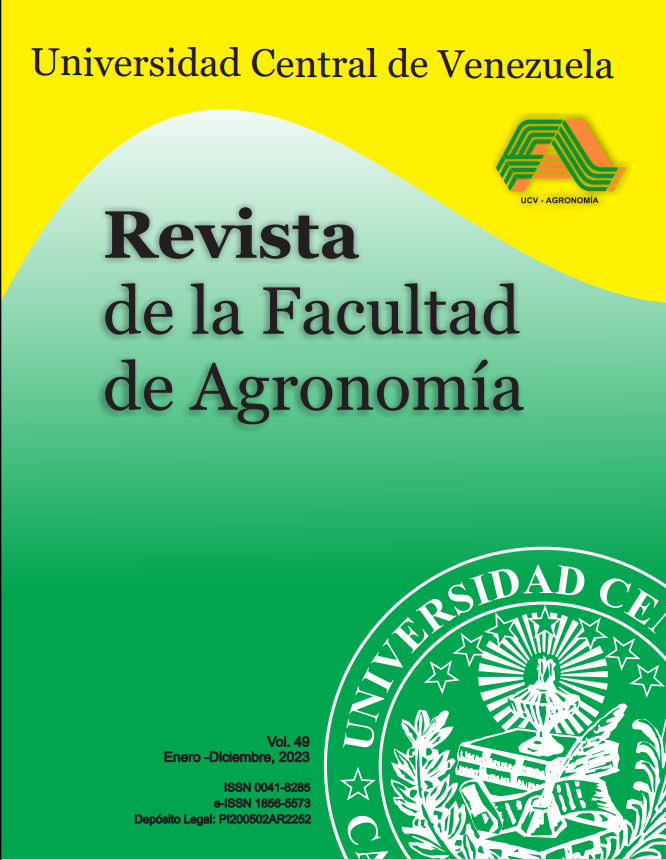Nuevos datos sobre monónquidos (Nematoda: Enoplea: Mononchida) en Venezuela
New data on mononchids (Nematoda: Enoplea: Mononchida) in Venezuela
Palabras clave:
Biodiversidad, Mononchida, nematodos, nuevos registros, taxonomía, Biodiversity, nematodes, new records, taxonomyResumen
En las siguientes notas, se aportan datos biométricos de una nueva población de Clarkus papillatus y se registran por primera vez las especies: Iotonchus clarki y Mulveyellus monhystera dentro de la nematofauna venezolana. Las hembras de C. papillatus, se caracterizaron por presentar un tamaño mediano del cuerpo (L = 0,96-1,2 mm y biomasa = 0,9-1,9 μg), en forma de “J” después de fijado; diente dorsal de mediano tamaño, situado en la mitad anterior de la cavidad bucal, ápice localizado a 79-89,4% de la base del estoma; b = 3,4-3,8, c = 15,2-18,8; vulva transversa y post-ecuatorial (V = 62,4-67%), dos piezas cuticularizadas en forma de gota (pars refrigens vaginae); cola arqueada ventralmente, glándulas caudales y escape (espinereta) ausentes. Las hembras de I. clarki, presentaron un cuerpo cilíndrico (L = 1,57-1,88 mm y biomasa = 3,1-4,5 μg), curvado ventralmente y en forma de “J” después de fijado; cavidad bucal en forma de barril, placas verticales (ventral y dorsal) ligeramente arqueadas, diente dorsal de pequeño tamaño situado cerca de la base del estoma (en posición suprabasal), con ápice localizado a 20-25,7% de dicha base; b = 5,1-5,3, c = 5,5-5,7; vulva transversa y postecuatorial (V = 53,6-57,3%); cola larga y filiforme, curvada ventralmente, glándulas caudales y espinereta no patentes o ausentes. Mientras que las hembras de M. monhystera, se caracterizaron por presentar un cuerpo curvado ventralmente en forma de “J” o de “C” abierta después de fijado (L = 1-1,29 mm y biomasa = 1,33-2,49 μg); diente dorsal de pequeño tamaño, con ápice ubicado a 59,1-70,6% de la base del estoma; b = 3,6-4,3; c = 17,4-24,8; vulva postecuatorial (V = 74,2-80,7%); cola conoide curvada ventralmente con término redondeado. Finalmente, se presenta un breve compendio biométrico de las especies del orden Mononchida señaladas en el país hasta la presente fecha.
ABSTRACT
These notes provide biometric data of a new population of Clarkus papillatus and the species: Iotonchus clarki and Mulveyellus monhystera are recorded for the first time in the Venezuelan nematofauna. C. papillatus females were characterized by having a medium body size (L = 0.96-1.2 mm and biomass = 0.9-1.9 μg), J-shape after fixed; medium-sized dorsal tooth, located in the anterior half of the oral cavity, apex located 79-89.4% from the base of the stoma; b = 3.4-3.8, c = 15.2-18.8; vulva transverse and post-equatorial (V = 62.4-67%), two drop-shaped cuticularized pieces (pars refrigens vaginae); tail arched ventrally, caudal glands and spinneret absent. I. clarki females had a cylindrical body (L = 1.57-1.88 mm and biomass = 3.1-4.5 μg), ventrally curved and J-shaped after fixed; barrel-shaped oral cavity, vertical plates (ventral and dorsal) slightly arched, small dorsal tooth located near the base of the stoma (in suprabasal position), with apex located 20-25.7% from said base; b = 5.1-5.3, c = 5.5-5.7; transverse and postequatorial vulva (V = 53.6-57.3%); tail long and filiform, curved ventrally, caudal glands and spinneret not patent or absent. While the females of M. monhystera were characterized by having a ventrally curved body, J or C-shape after fixed (L = 1-1.29 mm and biomass = 1.33-2, 49 μg); small dorsal tooth, with apex located 59.1-70.6% from the base of the stoma; b = 3.6-4.3; c = 17.4-24.8; postequatorial vulva (V = 74.2-80.7%); conoid tail curved ventrally with rounded terminus. Finally, a brief biometric compendium of the species of the order Mononchida reported in the country to date is also presented.


